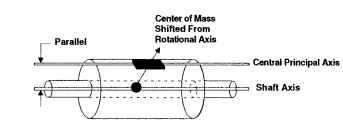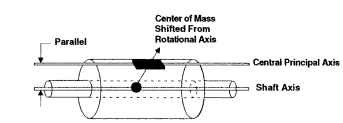3.14.3
The unbalance of a rotor does not change with speed but is solely due to its mass distribution about the bearing axis. The centripetal force generated by the unbalance increases with the square of the rotational speed change; therefore, the balance tolerance has to be determined for the maximum operating speed of the rotor.
The operating speed and bearing forces determine the bearing life, so the unbalance must be limited to achieve the required operating lifetime. The intensity of vibration (acceleration) must be limited to avoid noise and vibration apparent to the operator, which is proportional to the velocity of the vibration, which requires that the balancing tolerance be tightened as speed increases.
It is normally not necessary to balance a rotor at operating speed. In fact, the aim should always be to balance at the lowest practical speed. A lower balancing speed is preferable for a number of reasons. Faster speeds require a longer time to ramp up and ramp down and also require stronger, stiffer tooling arrangements and tighter clamping of the rotor assembly, which in turn increases the risk of distortion or damage. Lower speeds assure safety for the operator and require less elaborate machine guards. However, the performance of the balancing machine transducers and instrumentation improves with increasing speed due to the greater signal levels from the increase in centripetal force, illustrated in Fig. 3.92.

FIGURE 3.92 Effects of centripetal force on mass.
The requirements of tooling design, balance tolerance, cycle time, and machine guarding all interact when determining the optimum balancing speed.
The unbalance of a rotor does not change with speed but is solely due to its mass distribution about the bearing axis. The centripetal force generated by the unbalance increases with the square of the rotational speed change; therefore, the balance tolerance has to be determined for the maximum operating speed of the rotor.
The operating speed and bearing forces determine the bearing life, so the unbalance must be limited to achieve the required operating lifetime. The intensity of vibration (acceleration) must be limited to avoid noise and vibration apparent to the operator, which is proportional to the velocity of the vibration, which requires that the balancing tolerance be tightened as speed increases.
It is normally not necessary to balance a rotor at operating speed. In fact, the aim should always be to balance at the lowest practical speed. A lower balancing speed is preferable for a number of reasons. Faster speeds require a longer time to ramp up and ramp down and also require stronger, stiffer tooling arrangements and tighter clamping of the rotor assembly, which in turn increases the risk of distortion or damage. Lower speeds assure safety for the operator and require less elaborate machine guards. However, the performance of the balancing machine transducers and instrumentation improves with increasing speed due to the greater signal levels from the increase in centripetal force, illustrated in Fig. 3.92.

FIGURE 3.92 Effects of centripetal force on mass.
The requirements of tooling design, balance tolerance, cycle time, and machine guarding all interact when determining the optimum balancing speed.
Effects of Increased Speed (Electric Motors)
Next post: Resonance (Electric Motors)
Previous post: Characteristics of Static and Dynamic Unbalance (Electric Motors)
